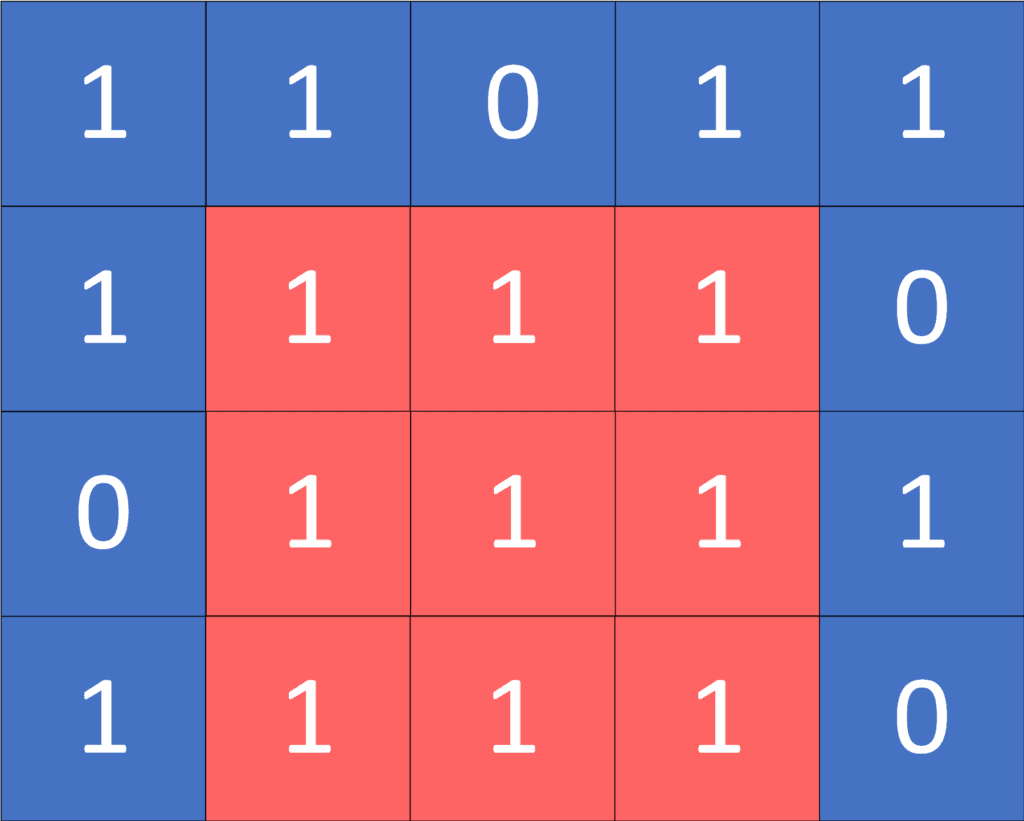1. 概述
在本教程中,我们将讨论如何在一个仅由0和1组成的二进制矩阵中,找出由1组成的最大正方形子矩阵。
我们会先定义问题,然后通过一个示例来解释它。接着,我们介绍四种不同的解法,并分析它们的时间复杂度。
2. 问题定义
我们被给定一个大小为 N × M 的二进制矩阵,每个单元格的值为0或1。我们的任务是找出由1组成的最大正方形子矩阵的边长。
来看一个示例:

图中,最大全1正方形子矩阵的左上角坐标为 (2, 2),右下角坐标为 (4, 4),边长为3。
3. 暴力法
3.1 思路
暴力法的核心思想是:遍历所有可能的左上角作为正方形的起点,然后枚举每一个可能的边长,判断该正方形是否全由1组成。
3.2 判断子矩阵是否全为1
boolean isFull(int[][] matrix, int x1, int y1, int x2, int y2) {
for (int i = x1; i <= x2; i++) {
for (int j = y1; j <= y2; j++) {
if (matrix[i][j] == 0) {
return false;
}
}
}
return true;
}
3.3 算法实现
int maxSquareBruteForce(int[][] matrix) {
int n = matrix.length;
int m = matrix[0].length;
int maxLen = 0;
for (int i = 0; i < n; i++) {
for (int j = 0; j < m; j++) {
for (int len = 1; i + len <= n && j + len <= m; len++) {
if (isFull(matrix, i, j, i + len - 1, j + len - 1)) {
maxLen = Math.max(maxLen, len);
}
}
}
}
return maxLen;
}
3.4 时间复杂度
- 时间复杂度:O(N² × M² × L),其中 N 是行数,M 是列数,L 是最大可能的正方形边长(即 min(N, M))
- 说明:对每个可能的左上角 (i, j),我们尝试所有可能的边长,并对每个边长遍历整个子矩阵进行判断
✅ 优点:思路简单,容易实现
❌ 缺点:效率极低,只能处理非常小规模的数据
4. 前缀和优化(动态规划)
4.1 思路
我们使用二维前缀和技巧来优化 isFull() 函数,使其能在 O(1) 时间内判断一个子矩阵是否全为1。
我们构建一个前缀和数组 prefix[i][j],表示从 (0, 0) 到 (i, j) 的子矩阵中所有元素的和。
构建公式如下:
prefix[i][j] = matrix[i][j] + prefix[i-1][j] + prefix[i][j-1] - prefix[i-1][j-1]
要判断一个子矩阵是否全为1,我们只需计算它的面积和对应的前缀和:
area = (x2 - x1 + 1) * (y2 - y1 + 1)
sum = prefix[x2][y2] - prefix[x1-1][y2] - prefix[x2][y1-1] + prefix[x1-1][y1-1]
return sum == area;
4.2 算法实现
int maxSquareDP(int[][] matrix) {
int n = matrix.length;
int m = matrix[0].length;
int[][] prefix = new int[n + 1][m + 1];
// Build prefix sum
for (int i = 1; i <= n; i++) {
for (int j = 1; j <= m; j++) {
prefix[i][j] = matrix[i - 1][j - 1] +
prefix[i - 1][j] +
prefix[i][j - 1] -
prefix[i - 1][j - 1];
}
}
int maxLen = 0;
for (int i = 1; i <= n; i++) {
for (int j = 1; j <= m; j++) {
for (int len = 1; i + len <= n + 1 && j + len <= m + 1; len++) {
int x1 = i, y1 = j;
int x2 = i + len - 1, y2 = j + len - 1;
int area = len * len;
int sum = prefix[x2][y2]
- prefix[x1 - 1][y2]
- prefix[x2][y1 - 1]
+ prefix[x1 - 1][y1 - 1];
if (sum == area) {
maxLen = Math.max(maxLen, len);
}
}
}
}
return maxLen;
}
4.3 时间复杂度
- 时间复杂度:O(N × M × L)
- 说明:虽然还是三重循环,但每次判断子矩阵是否全为1的时间降为 O(1)
✅ 优点:比暴力法快很多
❌ 缺点:仍不是最优解,复杂度仍较高
5. 二分查找法
5.1 思路
对于每个左上角,我们可以使用二分查找来快速确定以它为起点的最大正方形边长。
利用如下性质:
- 如果存在边长为 L 的全1正方形,那么所有边长小于 L 的正方形也一定存在
- 如果不存在边长为 L 的正方形,那么边长更大的也不可能存在
5.2 算法实现
int maxSquareBinarySearch(int[][] matrix) {
int n = matrix.length;
int m = matrix[0].length;
int[][] prefix = new int[n + 1][m + 1];
// Build prefix sum
for (int i = 1; i <= n; i++) {
for (int j = 1; j <= m; j++) {
prefix[i][j] = matrix[i - 1][j - 1] +
prefix[i - 1][j] +
prefix[i][j - 1] -
prefix[i - 1][j - 1];
}
}
int maxLen = 0;
for (int i = 1; i <= n; i++) {
for (int j = 1; j <= m; j++) {
int low = 1;
int high = Math.min(n - i + 1, m - j + 1);
while (low <= high) {
int mid = (low + high) / 2;
int x2 = i + mid - 1;
int y2 = j + mid - 1;
int area = mid * mid;
int sum = prefix[x2][y2]
- prefix[i - 1][y2]
- prefix[x2][j - 1]
+ prefix[i - 1][j - 1];
if (sum == area) {
maxLen = Math.max(maxLen, mid);
low = mid + 1;
} else {
high = mid - 1;
}
}
}
}
return maxLen;
}
5.3 时间复杂度
- 时间复杂度:O(N × M × log L)
- 说明:对每个左上角,我们用二分查找代替了线性查找,复杂度从 O(L) 降到 O(log L)
✅ 优点:比前两种方法快很多
❌ 缺点:实现稍复杂
6. 双指针法(滑动窗口)
6.1 思路
我们维护一个全局变量 len,表示当前找到的最大正方形边长。从左上到右下遍历每个点作为起点,尝试扩展当前的 len。
如果当前边长为 len 的正方形全为1,则尝试扩展为 len+1,否则跳过。
6.2 算法实现
int maxSquareTwoPointers(int[][] matrix) {
int n = matrix.length;
int m = matrix[0].length;
int len = 0;
for (int i = 0; i < n; i++) {
for (int j = 0; j < m; j++) {
while (i + len < n && j + len < m) {
boolean valid = true;
for (int k = 0; k <= len; k++) {
if (matrix[i + len][j + k] == 0 || matrix[i + k][j + len] == 0) {
valid = false;
break;
}
}
if (valid) {
len++;
} else {
break;
}
}
}
}
return len;
}
6.3 时间复杂度
- 时间复杂度:O(N × M + L)
- 说明:每个点最多被检查一次,且
len不会回退,所以整体复杂度接近线性
✅ 优点:时间复杂度最低,适合大规模数据
⚠️ 注意:实现细节容易出错,比如边界条件的处理
7. 总结
| 方法 | 时间复杂度 | 适用场景 |
|---|---|---|
| 暴力法 | O(N² × M² × L) | 数据量极小 |
| 前缀和优化 | O(N × M × L) | 中小规模数据 |
| 二分查找 | O(N × M × log L) | 中大规模数据 |
| 双指针法 | O(N × M + L) | 大规模数据 |
- ✅ 推荐使用 双指针法 或 二分查找法,它们在时间和实现复杂度之间取得了较好的平衡
- ⚠️ 如果数据量非常小,可以用暴力法,但要避免在实际项目中使用
- ✅ 前缀和优化是通用技巧,建议掌握,适用于很多子矩阵/子数组相关问题